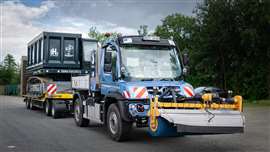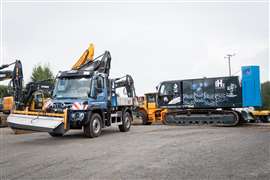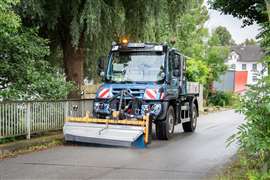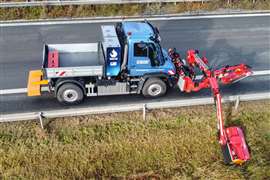Read this article in Français Deutsch Italiano Português Español
Prototypes demo H2 ICEs in special-purpose vehicles
12 August 2024
 The hydrogen-powered Unimog U 430 implement carrier transported the Mörtlbauer crawler on a low loader to the event on the Mörtlbauer company premises. (Photo: Daimler Truck)
The hydrogen-powered Unimog U 430 implement carrier transported the Mörtlbauer crawler on a low loader to the event on the Mörtlbauer company premises. (Photo: Daimler Truck)
After two years of development, Mercedes-Benz Special Trucks and Mörtlbauer Baumaschinen Vertriebs GmbH jointly presented two prototypes as part of the “WaVe” development project, established to research hydrogen internal combustion engines (H2-ICEs) for special-purpose vehicles. A demonstration of performance of the prototype Mercedes-Benz Unimog and Mörtlbauer crawler dumper took place on the Mörtlbauer factory premises in Fürstenzell, Bavaria, at the end of the project.
The test vehicles equipped with H2-ICEs were developed as part of the project funded by Germany’s Federal Ministry for Economic Affairs and Climate Action. The WaVe project was jointly realized by 18 partners from industry and science and started in July 2021. After a year of planning and preparations, development work on the prototypes began in mid-2022.
The Unimog and crawler dumper prototypes developed under the project are equipped with a medium-duty engine that was converted specifically for hydrogen propulsion. Customized pistons, a hydrogen-compatible intake system and an optimized ignition system were used for this purpose.
 After a short drive on its own tracks, the developers demonstrated refueling at a mobile hydrogen refueling station. (Photo: Daimler Truck)
After a short drive on its own tracks, the developers demonstrated refueling at a mobile hydrogen refueling station. (Photo: Daimler Truck)
On the Unimog, four TÜV-certified, 700 bar high-pressure tanks hold around 13 kg of gaseous hydrogen in total. The engine delivers roughly 290 hp/1,000 Nm, making it comparable to a 300-hp diesel variant in terms of output and torque.
The crawler dumper achieves similar values with its H2-ICE. Engine output is almost identical, and the fuel tank holds 14.5 kg of hydrogen at 700 bar. The crawler has a 360° rotating body, a dozer blade, a bed capacity of 16 cu. m. and can carry a payload of 30 metric tonnes.
The drive system in the Unimog implement carrier had already been in use for over a year for various tests. The crawler dumper was put into operation in Spring 2024 and has since proven itself in initial application-specific tests, the announcement stated.
For the demonstration, the specially converted Unimog U 430 implement carrier transported the crawler dumper on a low loader to the event. After a short drive on its own tracks, the developers demonstrated the refueling process at a mobile hydrogen refueling station. The Unimog also demonstrated implement operation with a front-mounted sweeper from Schmidt.
 The hydrogen-powered Unimog demonstrated implement operation with a front-mounted sweeper from Schmidt. (Photo: Daimler Truck)
The hydrogen-powered Unimog demonstrated implement operation with a front-mounted sweeper from Schmidt. (Photo: Daimler Truck)
“The fact that our crawler and the Mercedes-Benz Special Trucks Unimog can be easily refueled with gaseous hydrogen and that these vehicles also work reliably when using implements is the result of the outstanding cooperation in this research partnership. We have researched and understood this technology. We now have the corresponding experience and data,” said Armin Mörtlbauer, managing director of Mörtlbauer Baumaschinen Vertriebs GmbH. “However, to apply these in series production, we have to go even further on this path. “If the government and society choose to follow the path toward hydrogen combustion engines, we are ready to go.”
“The final event held together with our partner Mörtlbauer on their premises once again demonstrated that both vehicles have reached a development status that we can be very satisfied with, even though this project has run for just three years,” added Franziska Cusumano, head of Mercedes-Benz Special Trucks. “After numerous test deployments, emission measurements and technical fine tuning, we are convinced that hydrogen combustion for work machines with high power requirements – both for driving and for powering auxiliary drives – is worthwhile, practical and very low in emissions.”
POWER SOURCING GUIDE
The trusted reference and buyer’s guide for 83 years
The original “desktop search engine,” guiding nearly 10,000 users in more than 90 countries it is the primary reference for specifications and details on all the components that go into engine systems.
Visit Now
STAY CONNECTED




Receive the information you need when you need it through our world-leading magazines, newsletters and daily briefings.
CONNECT WITH THE TEAM














